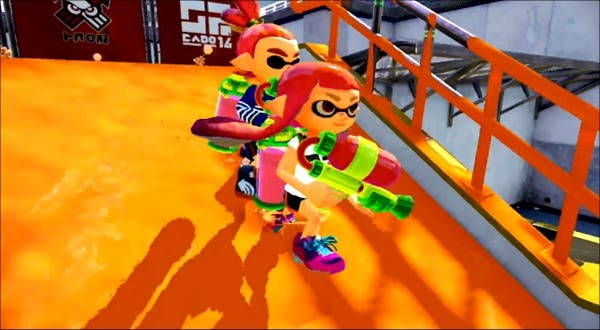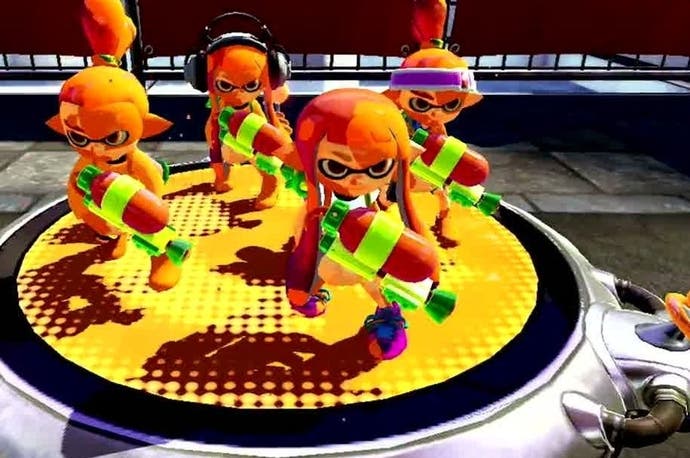Nintendo rediscovers the GamePad in glorious style
A selection of titles both big and small restores some of the Wii U's unique magic.
If last year's E3 was about helping introduce new hardware, then this year's show feels like it's been about hitting the reset button.
That's certainly true of a Microsoft that has rediscovered, with vigour, that it has a games machine to sell, and of a Nintendo that has reopened its eyes to the potential of its own Wii U. Back when the Wii U was first announced, Nintendo ushered players to a series of mini-games exploring what was possible with the GamePad - many of which would turn up later in the fantastic Nintendo Land - and now, some three years later, it's being introduced all over again.
There's a scrappiness to some of these new experiments, but that's no bad thing. Take Shigeru Miyamoto's own sketches: a surprisingly, somewhat endearingly rough pair of games playable on the show floor (his Star Fox doodle, sadly, isn't playable to those who don't write for high-profile US magazines). Project Giant Robot sees players building a huge mecha from a toy box of components before pitting them against a series of small challenges.

You slowly stomp backwards and forwards using the GamePad's shoulder buttons, rotating the robot's torso with the gyro and with each arm controlled by the pair of analogue sticks. It's a deliberately clunky interface, backed up with some playful physics as the robot clumsily bounds through a crudely realised cityscape, tearing through buildings and taking on other mechas. The main screen presents an isometric third person view, while the GamePad screen takes the perspective of the cockpit from which you're able to fire off lasers. It's knockabout, eminently likeable stuff.
Project Guard has slightly more substance, a tower defence game that actively encourages audience participation. On the main screen you're presented with a series of numbered cameras dotted around a lunar base under attack from scuttling bots modelled after Nintendo's own R.O.B, and on the GamePad you switch between each outpost, taking down attackers from each point. The enemies quickly overwhelm the player, so it's up to spectators to help by shouting out where the threat's coming from. Again it's a gentle experiment, lacking a little polish, and there's no clear details on how both games will see the light of day - though they're expected to in some form in 2015.?
Captain Toad: Treasure Tracker has a bit more sheen, as you'd expect from a game releasing towards the end of this year, and one coming from no less than the Tokyo EAD team responsible for Super Mario 3D World. It's an expansion of the mini-games featured in last year's mainline Wii U Mario outing, and they stand perfectly well on their own - the GamePad is used to switch perspective on self-contained levels, revealing new routes to reach the goal star. The idea is generously expanded on - a mine cart level has you using the GamePad to scout around and fire turnips at enemies, while a sumptuous dragon boss sends you up a fiery cavern avoiding globules of lava - and the game is exceptionally handsome, too.
Splatoon's the last to explore the GamePad, and it does so the most comprehensively. Somewhat controversially it uses gyro controls for aiming - although they're slick, well-implemented gyro controls - as well as making use of the touchscreen and the space between the GamePad and the television. You're in two teams of four, the objective simply being to paint as much of the map in your own colour as possible. It's a messy joy: the sound of paint slopping around surfaces is perfectly pitched, the feel of the weapons is wonderfully weighted.
It's very smart, too - if you've painted an area, you can turn into a squid and dive in, swiftly stalking your own territory. As a squid, you can also leap instantly to your team-mates by pointing to an icon that hovers over them in the mini-map displayed on the GamePad. At a show dominated, as ever, by straight-faced shooters looking for a point of distinction, it's incredible that Nintendo's created the most dynamic and quite simply joyous one on the show floor.
Nintendo has always been the place to go for simple, polished thrills, of course, but what's different this year is how an edge of experimentation has crept into so much of the company's offerings. It's often said that a Nintendo with its back against the wall is a Nintendo at its creative best, and given the current predicament of the Wii U, the E3 2014 line-up suggests there's some truth there. With new IPs rubbing shoulders with new ideas, this is the boldest, and brightest, Nintendo has been for some time.
It's not enough to drag the Wii U into the current console race, but that doesn't really matter. By doubling down on what makes the Wii U unique, Nintendo's rediscovered its key point of differentiation - and served a gentle reminder that its hardware is the place to go for pure, perfectly engineered and constantly surprising pleasure.


